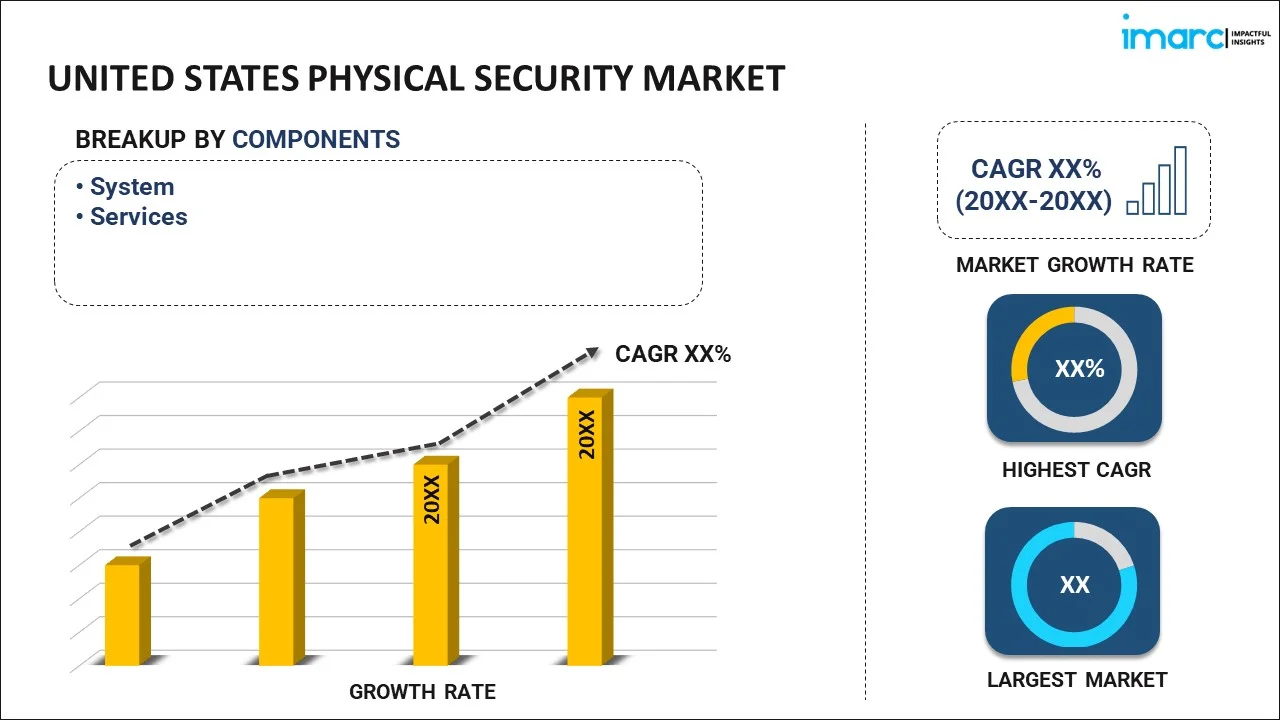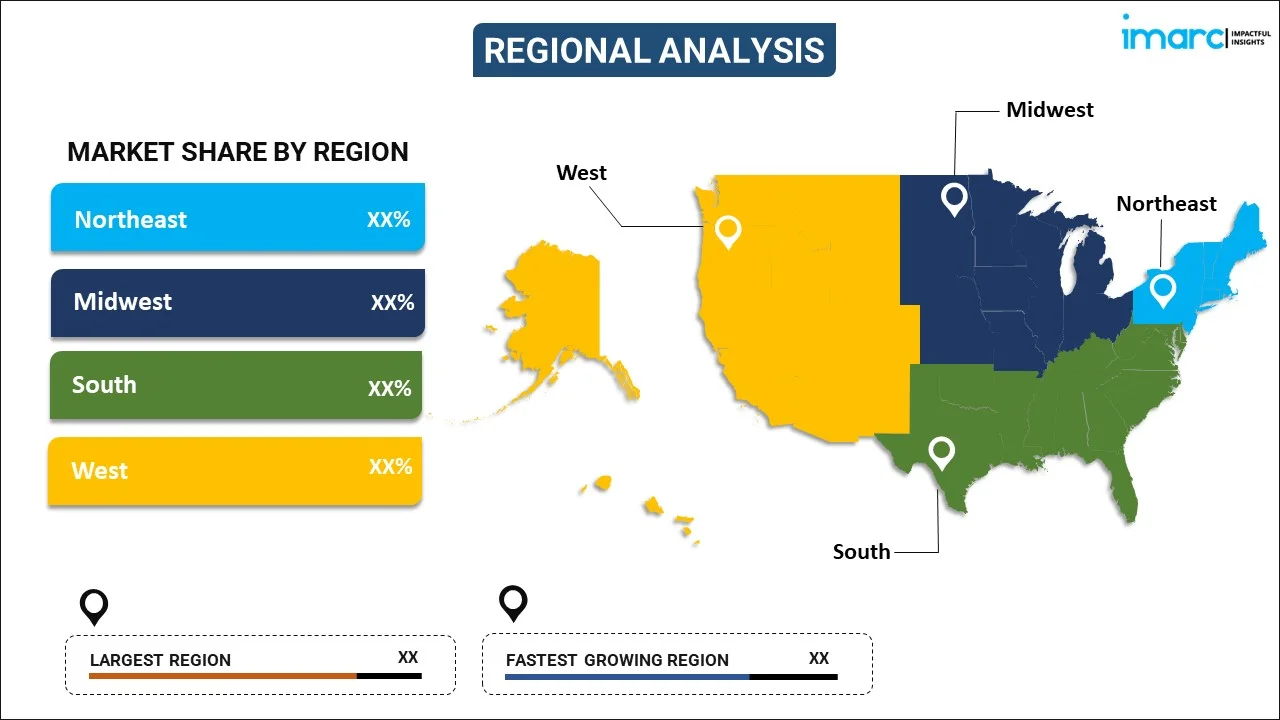
United States Physical Security Market Report by Component (System, Services), Enterprise Size (Large Enterprises, Small and Medium-sized Enterprises), Industry Vertical (Retail, Transportation, Residential, IT and Telecom, BFSI, Government, and Others), and Region 2025-2033
Market Overview:
United States physical security market size reached USD 30.7 Billion in 2024. Looking forward, IMARC Group expects the market to reach USD 45.6 Billion by 2033, exhibiting a growth rate (CAGR) of 4.5% during 2025-2033. The rising adoption of smart city initiatives and the integration of the Internet of Things (IoT) in security systems are primarily driving the market growth across the country.
|
Report Attribute
|
Key Statistics
|
|---|---|
|
Base Year
|
2024 |
|
Forecast Years
|
2025-2033
|
|
Historical Years
|
2019-2024
|
| Market Size in 2024 | USD 30.7 Billion |
| Market Forecast in 2033 | USD 45.6 Billion |
| Market Growth Rate (2025-2033) | 4.5% |
Physical security is a crucial measure aimed at safeguarding various elements such as tangible assets, personnel, software, hardware, networks, and property from potential physical threats or actions that could lead to significant loss or damage. These threats encompass a range of scenarios, including natural disasters, burglary, fire, floods, robbery, vandalism, terrorism, and theft. The implementation of physical security involves a multi-layered approach, utilizing interconnected systems like perimeter intrusion detection, access control, security systems, locks, deterrent systems, fire protection, CCTV surveillance, and the presence of security guards. By employing these measures, physical security plays a key role in monitoring and identifying security breaches, preventing unauthorized access to facilities, and fostering trust and confidence. Consequently, the application of physical security is widespread in various industries such as transportation, retail, information technology (IT), telecommunications, and the banking, financial services, and insurance (BFSI) sectors.
United States Physical Security Market Trends:
The United States physical security market is a dynamic and rapidly evolving sector that plays a pivotal role in safeguarding assets, infrastructure, and people across diverse industries. The market encompasses a broad spectrum of products and services, including advanced surveillance systems, access control systems, biometric authentication technologies, and perimeter security measures. Moreover, the integration of cutting-edge technologies, such as artificial intelligence and facial recognition, has further enhanced the capabilities of physical security systems, thereby bolstering the market growth. Besides this, the government, critical infrastructure facilities, commercial enterprises, and residential complexes are increasingly investing in comprehensive physical security solutions to mitigate risks posed by natural disasters, criminal activities, and acts of terrorism, which is acting as another significant growth-inducing factor. In recent years, there has been a notable emphasis on the convergence of physical and cybersecurity, fostering a more holistic approach to risk management. As threats continue to evolve, the United States physical security market is poised for continued expansion over the forecasted period.
United States Physical Security Market Segmentation:
IMARC Group provides an analysis of the key trends in each segment of the market, along with forecasts at the country level for 2025-2033. Our report has categorized the market based on component, enterprise size, and industry vertical.
Component Insights:

- System
- Physical Access System
- Video Surveillance System
- Perimeter Intrusion and Detection
- Physical Security Information Management
- Others
- Services
- System Integration
- Remote Monitoring
- Others
The report has provided a detailed breakup and analysis of the market based on the component. This includes system (physical access system, video surveillance system, perimeter intrusion and detection, physical security information management, and others) and services (system integration, remote monitoring, and others).
Enterprise Size Insights:
- Large Enterprises
- Small and Medium-sized Enterprises
A detailed breakup and analysis of the market based on the enterprise size have also been provided in the report. This includes large enterprises and small and medium-sized enterprises.
Industry Vertical Insights:
- Retail
- Transportation
- Residential
- IT and Telecom
- BFSI
- Government
- Others
The report has provided a detailed breakup and analysis of the market based on the industry vertical. This includes retail, transportation, residential, IT and telecom, BFSI, government, and others.
Regional Insights:

- Northeast
- Midwest
- South
- West
The report has also provided a comprehensive analysis of all the major regional markets, which include Northeast, Midwest, South, and West.
Competitive Landscape:
The market research report has also provided a comprehensive analysis of the competitive landscape. Competitive analysis such as market structure, key player positioning, top winning strategies, competitive dashboard, and company evaluation quadrant has been covered in the report. Also, detailed profiles of all major companies have been provided.
United States Physical Security Market Report Coverage:
| Report Features | Details |
|---|---|
| Base Year of the Analysis | 2024 |
| Historical Period | 2019-2024 |
| Forecast Period | 2025-2033 |
| Units | Billion USD |
| Scope of the Report | Exploration of Historical Trends and Market Outlook, Industry Catalysts and Challenges, Segment-Wise Historical and Future Market Assessment:
|
| Components Covered |
|
| Enterprise Sizes Covered | Large Enterprises, Small and Medium-sized Enterprises |
| Industry Verticals Covered | Retail, Transportation, Residential, IT and Telecom, BFSI, Government, Others |
| Regions Covered | Northeast, Midwest, South, West |
| Customization Scope | 10% Free Customization |
| Post-Sale Analyst Support | 10-12 Weeks |
| Delivery Format | PDF and Excel through Email (We can also provide the editable version of the report in PPT/Word format on special request) |
Key Questions Answered in This Report:
- How has the United States physical security market performed so far and how will it perform Size in the coming years?
- What has been the impact of COVID-19 on the United States physical security market?
- What is the breakup of the United States physical security market on the basis of component?
- What is the breakup of the United States physical security market on the basis of enterprise size?
- What is the breakup of the United States physical security market on the basis of industry vertical?
- What are the various stages in the value chain of the United States physical security market?
- What are the key driving factors and challenges in the United States physical security?
- What is the structure of the United States physical security market and who are the key players?
- What is the degree of competition in the United States physical security market?
Key Benefits for Stakeholders:
- IMARC’s industry report offers a comprehensive quantitative analysis of various market segments, historical and current market trends, market forecasts, and dynamics of the United States physical security market from 2019-2033.
- The research report provides the latest information on the market drivers, challenges, and opportunities in the United States physical security market.
- Porter's five forces analysis assist stakeholders in assessing the impact of new entrants, competitive rivalry, supplier power, buyer power, and the threat of substitution. It helps stakeholders to analyze the level of competition within the United States physical security industry and its attractiveness.
- Competitive landscape allows stakeholders to understand their competitive environment and provides an insight into the current positions of key players in the market.
Need more help?
- Speak to our experienced analysts for insights on the current market scenarios.
- Include additional segments and countries to customize the report as per your requirement.
- Gain an unparalleled competitive advantage in your domain by understanding how to utilize the report and positively impacting your operations and revenue.
- For further assistance, please connect with our analysts.
 Inquire Before Buying
Inquire Before Buying
 Speak to an Analyst
Speak to an Analyst
 Request Brochure
Request Brochure
 Request Customization
Request Customization




.webp)




.webp)












